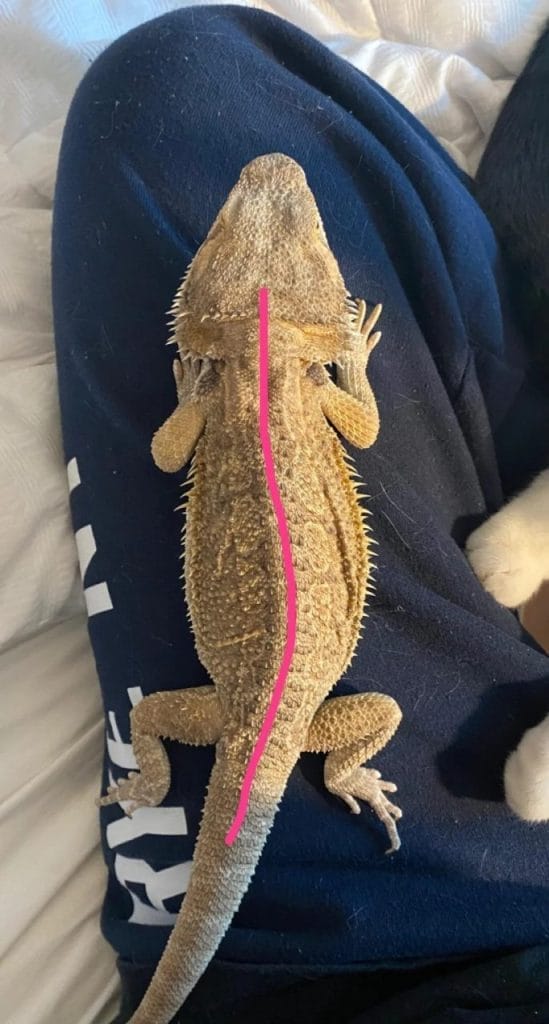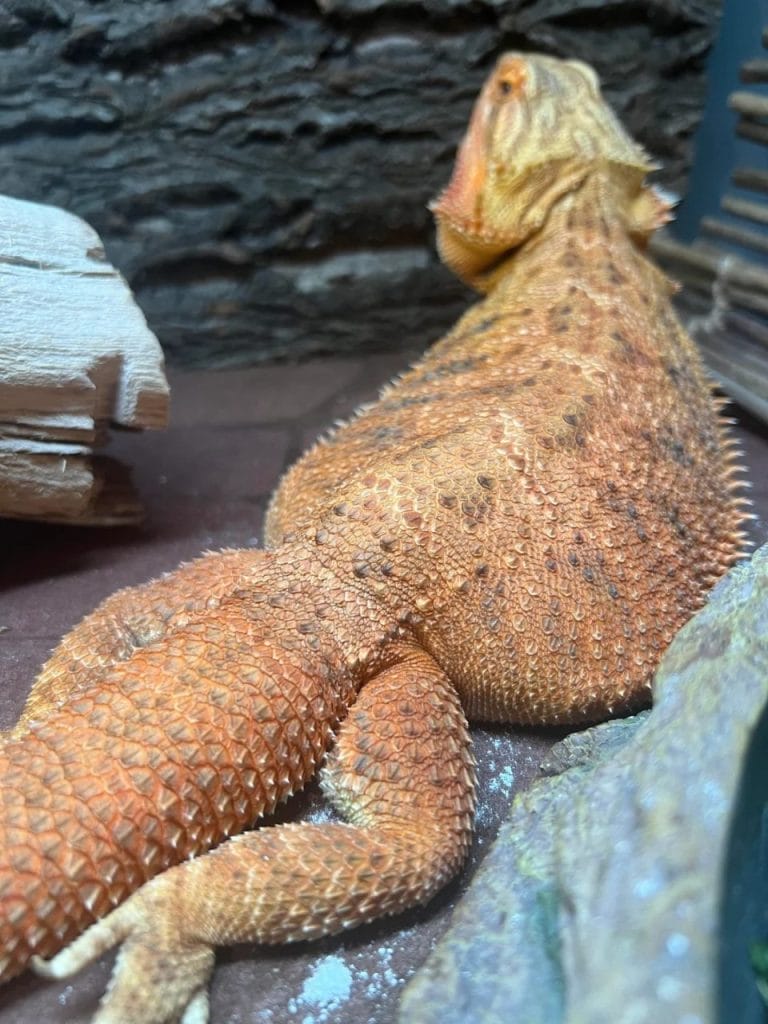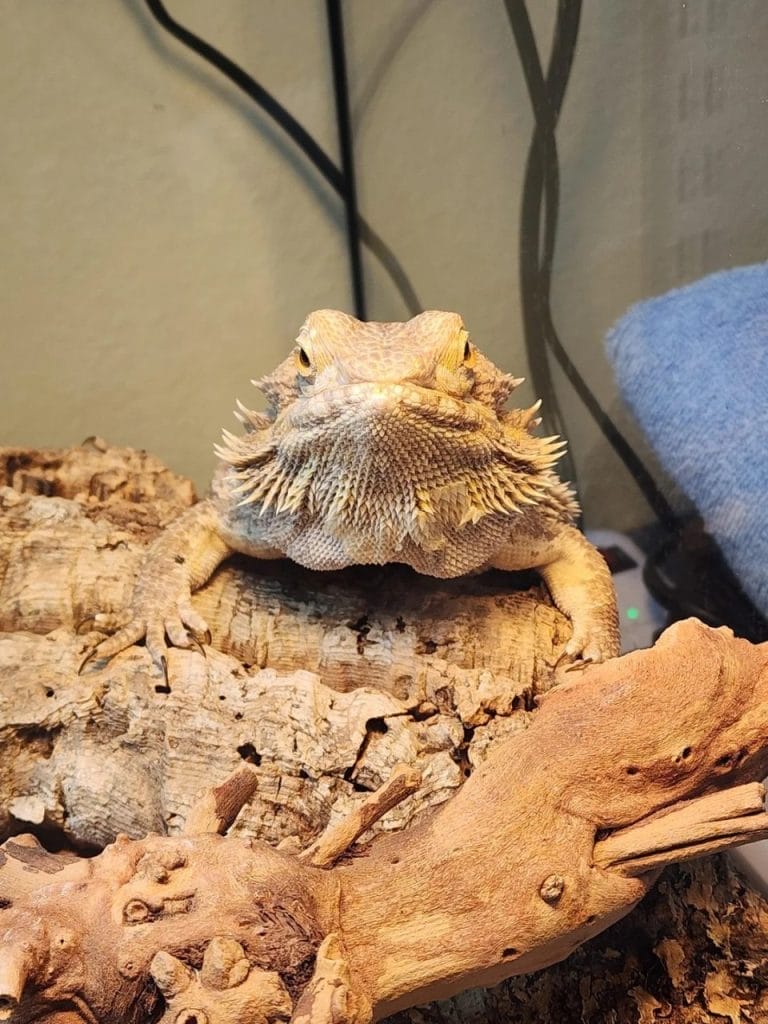This post was created with help from AI tools and carefully reviewed by a human (Muntaseer Rahman) . For more on how we use AI on this site, check out our Editorial Policy.
Check Out These FREE Tools We Made JUST For You!
Metabolic Bone Disease in Bearded Dragons: The Life-Saving Guide Every Owner Needs

Did you know that something as simple as improper lighting can put your bearded dragon’s life at risk?
Metabolic Bone Disease is one of the most common—and preventable—health issues in reptiles.
This guide will arm you with everything you need to protect your dragon from this silent, but deadly, threat.

What Is Metabolic Bone Disease?
Metabolic Bone Disease (MBD) is a serious health issue in bearded dragons. It messes with their bones, making them weak and brittle.
Basically, their bodies can’t balance calcium and other nutrients needed for strong bones. This leads to deformities, fractures, and even life-threatening conditions.
I learned about MBD the hard way. My first dragon, Spike, started limping one day. I thought he was just clumsy—big mistake!
What Causes MBD?
Here’s the breakdown:
- Lack of UVB Lighting: Bearded dragons need UVB light to process calcium. Without it, their bodies can’t absorb it properly.
- Poor Diet: Feeding too many insects and not enough leafy greens is a common mistake. Some foods even block calcium absorption.
- Low Vitamin D3: Without D3, calcium doesn’t do its job. D3 often comes from proper lighting or supplements.
What Happens to the Bones?
When a dragon has MBD:
- Bones become soft or rubbery.
- Joints swell.
- Their spine or jaw may bend.
I’ll never forget when Spike’s jaw looked crooked. I freaked out and rushed him to the vet. It turned out to be an early sign of MBD.
Why Is It Dangerous?
If untreated, MBD can:
- Cause paralysis.
- Lead to fractures.
- Even shut down vital organs.
Knowing this now, I realize how lucky Spike was that we caught it early.
How to Spot MBD Early
- Limping or weak limbs.
- A soft or pliable jaw.
- Difficulty eating or moving.
Take it from me—don’t ignore these signs. Early action can save your dragon’s life!
What Causes MBD in Bearded Dragons?
Metabolic Bone Disease (MBD) isn’t something that just happens. There are clear reasons why it develops. Most of them are tied to how we care for our dragons. Don’t feel bad—I made a few of these mistakes too when I was new to owning a beardie. Let’s break it down.
Poor UVB Lighting
Bearded dragons need UVB light to process calcium. Without it, their bones can’t grow strong.
- Wrong Bulbs: Not all UVB lights are good enough.
- Placement Problems: If the light is too far away, it doesn’t work.
- Old Bulbs: UVB bulbs lose their power over time—usually after 6 months.
When I got my first dragon, I didn’t realize my UVB bulb was expired. I felt terrible when I learned it wasn’t helping him at all.
Calcium Deficiency
Calcium keeps bones strong. If your dragon isn’t getting enough, their body starts stealing calcium from their bones.
- No Supplements: Dusting food with calcium powder is a must.
- Poor Ratios: Foods like spinach block calcium absorption.
I used to feed my beardie spinach every day, thinking I was being healthy. Oops—big mistake!
Improper Diet
Bearded dragons can’t thrive on junk food, even if they love it.
- Too Many Insects: Insects are high in phosphorus, which throws off the calcium balance.
- Wrong Veggies: Avoid foods high in oxalates, like beet greens.
- No Variety: A good diet has a mix of greens, veggies, and insects.
When I switched up my dragon’s diet, I noticed a huge difference in his energy.
Lack of Vitamin D3
Vitamin D3 helps dragons absorb calcium. Without it, even a perfect diet won’t work.
- Poor Lighting: Again, UVB is the hero here.
- No Supplementation: A sprinkle of D3 in their food can fill the gap.
Learning about UVB and D3 was an eye-opener for me. It’s like the missing puzzle piece.
Quick Tip Table
| Cause | Solution |
|---|---|
| Poor UVB Lighting | Replace bulbs every 6 months |
| Calcium Deficiency | Dust food with calcium daily |
| Improper Diet | Offer a mix of safe foods |
| Lack of Vitamin D3 | Use UVB + D3 supplements |

Your Beardie Has More to Say…
This article tells you WHAT to do, but do you know WHY your dragon needs it? Or what they’re thinking when you do it wrong?
Read the full rant (all 20 chapters of it) in: “What Your Bearded Dragon Wishes You Knew”
*Told by a very frustrated beardie who’s had ENOUGH of watching you guess.*
Signs and Symptoms of MBD in Bearded Dragons
Metabolic Bone Disease (MBD) doesn’t show up all at once. The signs can start small, so it’s important to know what to watch for.
Early Warning Signs
These are the first red flags:
- Limping or Weak Limbs: Your dragon might drag a leg or struggle to climb.
- Soft or Wobbly Jaw: Their jaw may bend slightly when chewing.
- Twitching or Tremors: You might notice shaking in their legs or toes.
When my bearded dragon, Spike, started limping, I thought he was just being lazy. Turns out, it was an early sign of MBD.
Advanced Symptoms
If MBD isn’t treated, it can get worse:
- Swollen Joints or Legs: Bones might look oddly thick in places.
- Deformities: A bent tail, arched back, or misshapen limbs.
- Lethargy: Sleeping more, moving less, and losing energy.
- Loss of Appetite: They stop eating, which makes things even worse.
I once met a dragon with a bent spine. It was heartbreaking to see the damage that couldn’t be undone.
Behavioral Changes
- Struggling to grip branches or decorations.
- A dull, less curious personality compared to their usual self.
Quick Comparison Table
| Healthy Dragon | MBD Warning Signs |
|---|---|
| Strong limbs, steady grip | Limping or dragging legs |
| Bright, curious personality | Lethargy, disinterest |
| Smooth movements | Twitching or spasms |
If you spot even one symptom, take action immediately. Catching it early can save your dragon’s life!
How to Prevent MBD in Bearded Dragons
Preventing MBD in bearded dragons isn’t rocket science. It’s all about getting the basics right. Trust me, a little effort now can save you a lot of heartbreak later.
Get the UVB Lighting Right
Bearded dragons need UVB to absorb calcium. Without it, their bones start to weaken.
Here’s what you need:
- A high-quality UVB bulb. Go for brands like ReptiSun or Arcadia.
- 12 hours a day. Make sure they get enough exposure.
- Proper placement. The bulb should be 10–12 inches away from your dragon.
Quick tip: Replace the bulb every 6 months. Even if it looks fine, UVB output fades.
Don’t Skip Calcium and Vitamin D3
Calcium is a big deal. Without it, your dragon’s bones won’t stand a chance.
Here’s my routine:
- Dust their food. Use calcium powder 4–5 times a week for babies, 2–3 times for adults.
- Add Vitamin D3. Use a supplement with D3 unless your UVB setup is flawless.
I learned this the hard way. My first dragon started showing signs of weakness because I didn’t supplement enough. Now, I never forget.
Feed Them Right
What they eat makes all the difference. A bad diet can block calcium absorption.
Stick to this:
- Staple greens: Collard greens, mustard greens, dandelion leaves.
- Healthy insects: Dubia roaches and black soldier fly larvae.
- Avoid these: Spinach, kale, and mealworms—they can mess with calcium levels.
Pro tip: Gut-load insects 24 hours before feeding. It’s like supercharging their nutrition.
Check Their Setup Regularly
Your dragon’s habitat is their whole world. Make sure it’s perfect.
- Basking spot: Keep it between 95°F and 105°F.
- Cool side: Around 75°F.
- Humidity: 30–40% is the sweet spot.
I make it a habit to tweak things every few weeks. It’s amazing what a small change can do.
Why Prevention Matters
Once you’ve seen a dragon struggle with MBD, you’ll never take shortcuts again. Prevention is way easier (and cheaper) than treatment. Plus, a happy, healthy dragon is so much more fun to have around!
Diagnosing MBD in Bearded Dragons
Figuring out if your bearded dragon has Metabolic Bone Disease (MBD) can feel overwhelming. Trust me, I’ve been there. But catching it early makes a world of difference.
Signs to Watch For
Your beardie might not tell you outright, but their body does. Here are some common signs:
- Limping or struggling to climb.
- A soft jaw or legs that seem “bendy.”
- Swollen joints or visible deformities.
- Shaking or trembling limbs.
If your dragon is acting weird, trust your gut and look closer.
When to Call the Vet
If you notice these symptoms, don’t wait. A reptile vet can confirm if it’s MBD or something else.
I once hesitated to call the vet for my dragon, thinking it was “just a phase.” Spoiler: it wasn’t. A quick vet visit saved him a lot of pain.
How MBD Is Diagnosed?
Vets have some cool tools to get answers. Here’s what they might do:
Physical Exam
- They’ll check for soft bones or abnormal swelling.
- Your vet may test how your dragon moves.
X-Rays
- These show how strong your dragon’s bones are.
- It’s the best way to spot fractures or bone thinning.
Blood Tests
- These measure calcium, phosphorus, and vitamin D3 levels.
- It tells the vet if the issue is diet-related.
DIY Bone Health Check
You can keep tabs on your beardie’s bones at home, too.
- Feel their jaw and legs gently. Are they firm or squishy?
- Watch how they climb or walk. Limping is a red flag.
- Snap a photo each month to track growth and posture.
I did this with my dragon, and those monthly photos helped me spot a slight bend in his tail early.
Why Early Diagnosis Matters
Catching MBD early means:
- Less pain for your dragon.
- Easier (and cheaper!) treatment.
- A better chance for a full recovery.
Don’t second-guess yourself. If something seems off, it’s better to check than regret it later.
Treating MBD in Bearded Dragons
Metabolic Bone Disease is scary, but it’s not the end. With the right care, your dragon can bounce back. I’ve been there, and I know it takes patience and love.
Step 1: See a Reptile Vet
If you suspect MBD, go to the vet ASAP. They’ll confirm the diagnosis and get your dragon started on treatment.
Here’s what the vet might do:
- Prescribe calcium and vitamin D3 injections.
- Recommend X-rays to check bone damage.
- Offer advice on long-term care.
Trust me, this step is crucial. My vet was a lifesaver when I felt completely lost.
Step 2: Fix the Lighting
UVB lighting is non-negotiable. Without it, your dragon can’t process calcium.
Lighting tips:
- Use a high-quality 10.0 UVB bulb.
- Position it 10–12 inches from their basking spot.
- Replace the bulb every 6 months (even if it still lights up).
When I swapped my dragon’s light for a better one, I noticed a difference in days. It’s like they got their energy back!
Step 3: Adjust Their Diet
Diet is a huge part of recovery. Your dragon needs foods high in calcium and low in phosphorus.
What to feed:
- Calcium-rich greens: Collards, mustard greens, turnip greens.
- Gut-loaded insects: Crickets and dubia roaches.
What to avoid:
- Spinach (it blocks calcium).
- Lettuce (too watery, no nutrients).
I started dusting their food with calcium powder daily. It’s easy and makes a big difference.
Step 4: At-Home Care
Recovery takes time. Be gentle and patient as they heal.
How you can help:
- Set up a comfortable enclosure with proper heat and UVB.
- Handle them carefully to avoid stressing weak bones.
- Stick to the treatment plan from the vet.
I made a “spa corner” in my dragon’s tank with a soft towel and extra warmth. They loved it and seemed calmer during recovery.
Step 5: Monitor Progress
Keep a close eye on their behavior and appearance. Are they eating better? Moving more? Gaining strength?
Take notes and share them with your vet during follow-ups. This helped me feel more in control during my dragon’s recovery.
Common Myths About MBD in Bearded Dragons
Common myths about MBD can be harmful to your bearded dragon. Let’s clear up some confusion!
“Bearded Dragons Don’t Need Supplements If They Eat Insects”
This is false. Insects are high in protein, but they don’t provide enough calcium.
I thought skipping supplements was no big deal. Then my dragon, Spike, started showing weak legs. Trust me—dust those bugs!
“Natural Sunlight Is Enough, Even Indoors”
Sunlight is great, but it doesn’t work through windows. Glass blocks UVB rays.
Unless your dragon spends time outside in direct sunlight, you’ll still need a UVB bulb. I learned this the hard way after trying the “window trick.” It didn’t work, and Spike suffered.
“MBD Isn’t Fatal”
This is one of the most dangerous myths.
Without treatment, MBD can cause permanent damage—or worse. I’ve read heartbreaking stories of dragons whose owners waited too long to act. Don’t take that risk.
Quick Myth-Busting Recap
- Insects alone aren’t enough—calcium is crucial.
- Sunlight through windows won’t replace UVB bulbs.
- MBD can be fatal if ignored.
When it comes to MBD, believing myths can be costly. Your dragon’s health is worth getting the facts right!
Frequently Asked Questions
What are the best dietary changes to prevent metabolic bone disease in bearded dragons?
Feed your bearded dragon a balanced diet rich in calcium. Leafy greens like collard greens, mustard greens, and dandelion greens are excellent choices. Avoid foods high in oxalates, like spinach, as they block calcium absorption. Dust insects with calcium powder at least 4–5 times a week, especially for younger dragons.
How does improper UVB lighting contribute to metabolic bone disease?
UVB lighting is crucial for your dragon to produce vitamin D3, which helps them absorb calcium. Without enough UVB exposure, their body can’t process the calcium they consume, leading to weak bones. Improper lighting—like using the wrong bulb or placing it too far away—can result in MBD over time.
What are the early signs of metabolic bone disease in bearded dragons?
Look for signs like difficulty walking, soft or swollen jaw, and twitching muscles. You may also notice your dragon acting lethargic or losing appetite. If caught early, these symptoms can often be reversed with proper care.
How can I ensure my bearded dragon is getting enough calcium and vitamin D3?
Use a high-quality calcium supplement and dust their food regularly. Make sure your UVB bulb is working properly and replace it every 6–12 months, depending on the brand. Monitor their diet closely and include calcium-rich foods like turnip greens and gut-loaded insects.
What are the most common mistakes that lead to metabolic bone disease in bearded dragons?
- Not providing adequate UVB lighting or replacing old bulbs.
- Skipping calcium or vitamin D3 supplements.
- Feeding improper diets, such as too many insects or calcium-blocking foods.
- Assuming symptoms of MBD will go away on their own.
Preventing MBD is all about consistency—proper lighting, diet, and supplements make a huge difference!
About Author
Hello, I’m Muntaseer Rahman, the owner of AcuarioPets.com. I’m passionate about aquarium pets like shrimps, snails, crabs, and crayfish. I’ve created this website to share my expertise and help you provide better care for these amazing pets.
Disclaimer
This site is owned and operated by Muntaseer Rahman. AcuarioPets.com is a participant in the Amazon Services LLC Associates Program, an affiliate advertising program designed to provide a means for sites to earn advertising fees by advertising and linking to Amazon.com. This site also participates in other affiliate programs and is compensated for referring traffic and business to these companies.










